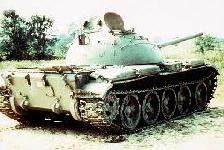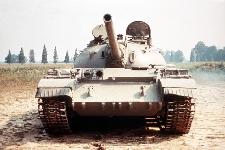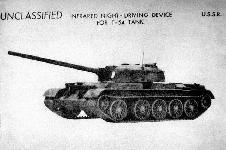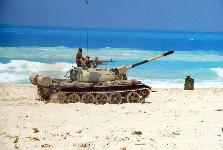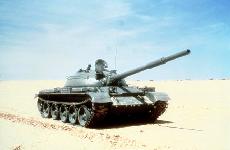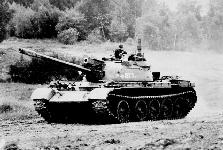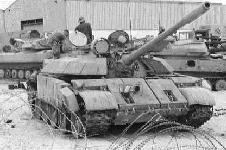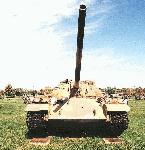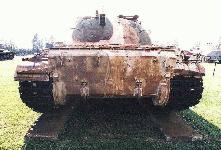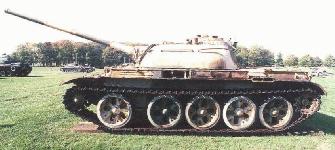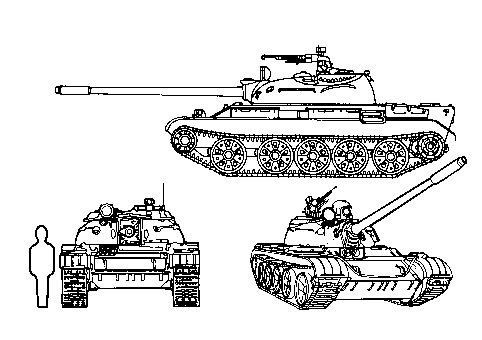
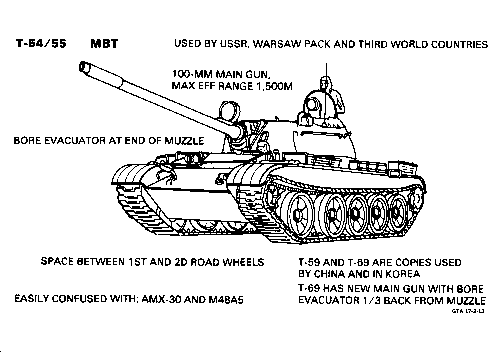




The layout of the T-54 is conventional, with the main armament comprising a 100mm rifled gun. The T-54 has been used more than any other tank since the Second World War. The T-55 combines a high velocity gun with exceptional long-range endurance. The T-55 has a fully tracked, five-road-wheeled chassis with a low-silhouetted hull and a dome shaped turret.
The T-54 series tanks first appeared in 1949 as replacements for the T-34 tank of World War II. The first T-54 prototype was completed in 1946 with first production beginning in 1947. The T-54 was continuously improved and modified, and, when sufficient changes had been made, the tank was redesignated T-55. The T-55 was introduced in 1958 and incorporates all the refinements and improvements of the fully developed T-54 series without being radically different in design or appearance. The T-55A appeared in the early 1960s. Production continued in the Soviet Union through 1981 and was also undertaken in China (as the Type 59), Czechoslovakia and Poland.
Large numbers are still in service, although by the 1980s the T-54/55 had been replaced by the T-62,T-64,T-72, and T-80 as the primary main battle tank in first-line Soviet tank and motorized rifle units. Used in the invasion of Hungary in 1956, Czechoslovakia in 1968, and Syria in 1970, it was the main Arab tank in the 1967 and 1973 wars with Israel. During the 1970s, the T-54 saw combat in Vietnam, Cambodia, and Uganda.
DESCRIPTION:
The T-55 medium tank has a fully tracked, five-road wheeled chassis with a space between the first and second road wheels and no return rollers. It has a low-silhouetted hull with a dome-shaped turret mounted over the third road wheel. The 100-mm rifle-bore main gun has a bore evacuator at the muzzle. A 7.62-mm coaxial machine gun and 7.62-mm bow machine gun are also mounted. The later T-55A version lacks the bow machine gun.
The T-55 is distinguishable from the other T-54 models in that it lacks the right-hand cupola and the turret dome ventilator located in front of that cupola on the T-54. Most T-55s also lack the turret-mounted 12.7-mm AA machine gun of the T-54, and all T-55s mount an infrared gunner's searchlight above and to the right of the main gun. This searchlight, however, is not a distinguishing feature, since it has been retrofitted to many T-54 and T-54A tanks.
CAPABILITIES:
The T-55 combines a high-velocity gun with a highly mobile chassis, a low silhouette, and exceptional long-range endurance. Improvements over the T-54 include a larger V-12 water-cooled diesel engine with 580 hp rather than 520 hp, increased cruising range of 500km (up to 715 km with two 200-liter auxiliary fuel tanks which can be carried on the rear) rather than 400 km (600 km with auxiliary tanks). The T-55 also has two-plane stabilization of the main gun rather than vertical stabilization only, and a basic load for the main gun of 43 rounds rather than 34.
The T-55, which can ford depths of 1.4 meters without preparation, has snorkel equipment which enables it to cross depths of up to 5.5 meters at a speed of 2 km/hr. This equipment takes about 1 5 to 30 minutes preparation but can be jettisoned immediately on leaving the water. All T-55s have the PAZ radiation detection system, and the T-55A also has an anti-radiation liner. Some T-55s also may have been retrofitted with a full NBC collective protection system (air filtration and overpressure). A dense smoke screen can be generated by injecting vaporized diesel fuel into the exhaust system.
T-55s with "bra armor", semi-circular add-on armor, have turret protection increased to 330 mm (KE) and 400-450 mm (CE). Other improvements available include a hull bottom reinforced against mines, better engines, rubber track pads, and a thermal sleeve for the gun. The 1K13 sight is both night sight and ATGM launcher sight; however, it cannot be used for both functions simultaneously. Optional sights and fire control systems include the Israeli El-Op Red Tiger and Matador FCS, Swedish NobelTech T-series sight, and German Atlas MOLF. The Serbian SUV-T55A FCS, British Marconi Digital FCS, South African Tiger, and Belgian SABCA Titan offer upgraded function. One of the best is the Slovenian EFCS-3 integrated FCS. A variety of thermal sights is available. They include the Russian/French ALIS and Namut-type sight from Peleng. There are thermal sights available for installation which permit night launch of ATGMs.The first operational active protection system [APS], named Drozd, was developed by the Soviet Union between 1977 and 1982. This system was installed on some 250 naval infantry T-55As (redesigned T-55ADs) in the early 1980s, and was designed for protection from ATGMs and antitank grenades. It used primitive millimeter-wave radar sensors on each side of the turret to detect incoming rounds. A filter in the radar processor was intended to ensure that the system responded only to targets flying at speeds typical of ATGMs. These are engaged by one or more short-range rockets carrying fragmentation warheads (similar to mortar rounds), fired from four-round launchers (one on each side of the turret). Drozd provides maximum overlap and protection only to the forward 60� portion of the turret, leaving the sides and rear vulnerable. The tank crew can change the orientation of the system by rotating the turret.
Drozd suffered from several shortcomings. Its radar was unable to determine threat elevation levels adequately, and the self-defense rockets would almost certainly have caused unacceptably high levels of collateral damage � particularly to accompanying dismounted infantry.
LIMITATIONS:
The T-55 is most effective against light to medium armor vehicles. The basic ammunition load for the main gun is 43 rounds. External fuel cells make the tank very vulnerable, as does its thin armor protection. The T-55 has a limited ability to depress the main gun, hindering the tank�s fires in defilade from high ground. In addition the gunner�s primary sight is slaved to the main gun, which does not allow the gunner to acquire targets in a hull-down posture.
Although the half-egg shaped turret of the T-55 has good ballistic qualities, it provides cramped working conditions for the crew, resulting in a slow rate of fire; and the protection afforded by its low silhouette (1 meter lower than the M60) is counterbalanced by its poor armor protection which is thin by western standards. By the same standards, its gun control equipment is also crude. It shares the disadvantage of most Soviet tanks in having limited ability to depress the main gun, thus not being capable of firing effectively from defilade and being forced to expose itself to engage targets. Ammunition and fuel are stored in vulnerable positions. The lack of a turret basket presents loading difficulties, and there is limited ready ammunition. The driver, commander, and gunner are all in line.
The T-55 is not airtight. Although crew members are protected from radioactive dust by the filtration system, they must wear individual protective masks and clothing to guard against chemical and biological agents. The tank must thus pass through contaminated areas rapidly and then be decontaminated before it is fully operational.
The tank can be made watertight for fording water obstacles up to 1.4 meters deep (5.5 meters with snorkel). However, it may take up to half an hour to prepare a medium tank unit for a snorkeling operation, and entrance and exit points may also require preparation.
Specifications | |||||||||||||||||||||||||||||||||||||||||||||||||||||||||||||||
| Alternative Designations | T-55AMV | ||||||||||||||||||||||||||||||||||||||||||||||||||||||||||||||
| Date of Introduction | 1983 | ||||||||||||||||||||||||||||||||||||||||||||||||||||||||||||||
| Proliferation |
| ||||||||||||||||||||||||||||||||||||||||||||||||||||||||||||||
| Description | |||||||||||||||||||||||||||||||||||||||||||||||||||||||||||||||
| Crew | 4 | ||||||||||||||||||||||||||||||||||||||||||||||||||||||||||||||
| Combat Weight (mt) | 40.5 | ||||||||||||||||||||||||||||||||||||||||||||||||||||||||||||||
| Chassis Length Overall (m) | 6.20 | ||||||||||||||||||||||||||||||||||||||||||||||||||||||||||||||
| Height Overall (m) | 2.32 | ||||||||||||||||||||||||||||||||||||||||||||||||||||||||||||||
| Width Overall (m) | 3.60 | ||||||||||||||||||||||||||||||||||||||||||||||||||||||||||||||
| Ground Pressure (kg/cm 2 ) | 0.89 | ||||||||||||||||||||||||||||||||||||||||||||||||||||||||||||||
| Automotive Performance | |||||||||||||||||||||||||||||||||||||||||||||||||||||||||||||||
| Engine Type | 620-690 hp Diesel | ||||||||||||||||||||||||||||||||||||||||||||||||||||||||||||||
| Cruising Range (km) | 390/600 with extra tanks | ||||||||||||||||||||||||||||||||||||||||||||||||||||||||||||||
| Speed (km/h) | |||||||||||||||||||||||||||||||||||||||||||||||||||||||||||||||
| Max Road | 50 | ||||||||||||||||||||||||||||||||||||||||||||||||||||||||||||||
| Max Off-Road | 35 | ||||||||||||||||||||||||||||||||||||||||||||||||||||||||||||||
| Average Cross-Country | 25 | ||||||||||||||||||||||||||||||||||||||||||||||||||||||||||||||
| Max Swim | N/A | ||||||||||||||||||||||||||||||||||||||||||||||||||||||||||||||
| Fording Depths (m) | 1.4 Unprepared, 5.5 with snorkel | ||||||||||||||||||||||||||||||||||||||||||||||||||||||||||||||
| Radio | R-173, R-173P, R-124 intercom | ||||||||||||||||||||||||||||||||||||||||||||||||||||||||||||||
| Protection | |||||||||||||||||||||||||||||||||||||||||||||||||||||||||||||||
| Armor, Turret Front (mm) | 200 (base T-55 armor) | ||||||||||||||||||||||||||||||||||||||||||||||||||||||||||||||
| Applique Armor (mm) | Rubber screens and box armor | ||||||||||||||||||||||||||||||||||||||||||||||||||||||||||||||
| Explosive Reactive Armor (mm) | 1st Gen raises to KE/700-900 | ||||||||||||||||||||||||||||||||||||||||||||||||||||||||||||||
| against HEAT; 2nd Gen raises to 450-480 KE/700-900 HEAT | |||||||||||||||||||||||||||||||||||||||||||||||||||||||||||||||
| Active Protective System | Russian Drozd APS available | ||||||||||||||||||||||||||||||||||||||||||||||||||||||||||||||
| Mineclearing Equipment | Roller-plow set, and plows available | ||||||||||||||||||||||||||||||||||||||||||||||||||||||||||||||
| Self-Entrenching Blade | No | ||||||||||||||||||||||||||||||||||||||||||||||||||||||||||||||
| NBC Protection System | Yes | ||||||||||||||||||||||||||||||||||||||||||||||||||||||||||||||
| Smoke Equipment | Smoke grenade launchers (4x 81-mm each side of turret), and 24 grenades. Vehicle engine exhaust smoke system | ||||||||||||||||||||||||||||||||||||||||||||||||||||||||||||||
| ARMAMENT | |||||||||||||||||||||||||||||||||||||||||||||||||||||||||||||||
| Main Armaments | |||||||||||||||||||||||||||||||||||||||||||||||||||||||||||||||
| Caliber, Type, Name | 100-mm rifled gun, D-10T2S | ||||||||||||||||||||||||||||||||||||||||||||||||||||||||||||||
| Rate of Fire (rd/min) | 5-7 | ||||||||||||||||||||||||||||||||||||||||||||||||||||||||||||||
| Loader Type | Manual | ||||||||||||||||||||||||||||||||||||||||||||||||||||||||||||||
| Ready/Stowed Rounds | INA | ||||||||||||||||||||||||||||||||||||||||||||||||||||||||||||||
| Elevation (�) | -5 to +18 | ||||||||||||||||||||||||||||||||||||||||||||||||||||||||||||||
| Fire on Move | Yes (gun rounds only--ATGMs require a short halt) | ||||||||||||||||||||||||||||||||||||||||||||||||||||||||||||||
| Auxiliary Weapon | |||||||||||||||||||||||||||||||||||||||||||||||||||||||||||||||
| Caliber, Type, Name | 7.62-mm (7.62x 54R) Machinegun PKT-T | ||||||||||||||||||||||||||||||||||||||||||||||||||||||||||||||
| Mount Type | Turret coax | ||||||||||||||||||||||||||||||||||||||||||||||||||||||||||||||
| Maximum Aimed Range (m) | 2,000 | ||||||||||||||||||||||||||||||||||||||||||||||||||||||||||||||
| Max Effective Range (m) | |||||||||||||||||||||||||||||||||||||||||||||||||||||||||||||||
| Day | 800 | ||||||||||||||||||||||||||||||||||||||||||||||||||||||||||||||
| Night | 800 | ||||||||||||||||||||||||||||||||||||||||||||||||||||||||||||||
| Fire on Move | Yes | ||||||||||||||||||||||||||||||||||||||||||||||||||||||||||||||
| Rate of Fire (rd/min) | 250 rpm practical, 800 cyclic, 2-10 rd bursts | ||||||||||||||||||||||||||||||||||||||||||||||||||||||||||||||
| Caliber, Type, Name | 12.7-mm (12.7x108) AA MG DShKM | ||||||||||||||||||||||||||||||||||||||||||||||||||||||||||||||
| Mount Type | Turret top | ||||||||||||||||||||||||||||||||||||||||||||||||||||||||||||||
| Maximum Aimed Range (m) | 2,000 | ||||||||||||||||||||||||||||||||||||||||||||||||||||||||||||||
| Max Effective Range (m) | |||||||||||||||||||||||||||||||||||||||||||||||||||||||||||||||
| Day | 1,500 | ||||||||||||||||||||||||||||||||||||||||||||||||||||||||||||||
| Night | N/A | ||||||||||||||||||||||||||||||||||||||||||||||||||||||||||||||
| Fire on Move | Yes | ||||||||||||||||||||||||||||||||||||||||||||||||||||||||||||||
| Rate of Fire (rd/min) | 80-100 practical, 600 cyclic, 2-10 rd bursts | ||||||||||||||||||||||||||||||||||||||||||||||||||||||||||||||
| ATGM Launcher | |||||||||||||||||||||||||||||||||||||||||||||||||||||||||||||||
| Name | D-10T2S gun | ||||||||||||||||||||||||||||||||||||||||||||||||||||||||||||||
| Launch Method | Gun-launched | ||||||||||||||||||||||||||||||||||||||||||||||||||||||||||||||
| Guidance | SACLOS, Infrared laser-beam rider | ||||||||||||||||||||||||||||||||||||||||||||||||||||||||||||||
| Command Link | Encoded laser-beam | ||||||||||||||||||||||||||||||||||||||||||||||||||||||||||||||
| Launcher Dismountable | No | ||||||||||||||||||||||||||||||||||||||||||||||||||||||||||||||
| FIRE CONTROL | |||||||||||||||||||||||||||||||||||||||||||||||||||||||||||||||
| FCS Name | Volna | ||||||||||||||||||||||||||||||||||||||||||||||||||||||||||||||
| Main Gun Stabilization | M1 Tsiklon 2-plane | ||||||||||||||||||||||||||||||||||||||||||||||||||||||||||||||
| Rangefinder | KDT-2 Laser | ||||||||||||||||||||||||||||||||||||||||||||||||||||||||||||||
| Infrared Searchlight | L-4 | ||||||||||||||||||||||||||||||||||||||||||||||||||||||||||||||
| Sights w/Magnification | |||||||||||||||||||||||||||||||||||||||||||||||||||||||||||||||
| Gunner | |||||||||||||||||||||||||||||||||||||||||||||||||||||||||||||||
| Day | TShSM-32PV, 3.5x and 7x | ||||||||||||||||||||||||||||||||||||||||||||||||||||||||||||||
| Field of View (�) | 18 and 8 | ||||||||||||||||||||||||||||||||||||||||||||||||||||||||||||||
| Acquisition Range (m) | 4,000 | ||||||||||||||||||||||||||||||||||||||||||||||||||||||||||||||
| Night | 1K13 | ||||||||||||||||||||||||||||||||||||||||||||||||||||||||||||||
| Field of View (�) | INA | ||||||||||||||||||||||||||||||||||||||||||||||||||||||||||||||
| Acquisition Range (m) | 800-1,300, gun rounds only | ||||||||||||||||||||||||||||||||||||||||||||||||||||||||||||||
| Commander Fire Main Gun | No | ||||||||||||||||||||||||||||||||||||||||||||||||||||||||||||||
| MAIN ARMAMENT AMMUNITION | |||||||||||||||||||||||||||||||||||||||||||||||||||||||||||||||
| Caliber, Type, Name | |||||||||||||||||||||||||||||||||||||||||||||||||||||||||||||||
| 100-mm BM-8 Russian | |||||||||||||||||||||||||||||||||||||||||||||||||||||||||||||||
| Maximum Aimed Range (m) | 2,500 Max Effective Range (m) | ||||||||||||||||||||||||||||||||||||||||||||||||||||||||||||||
| Day | 1,500 | ||||||||||||||||||||||||||||||||||||||||||||||||||||||||||||||
| Night | 800-1,300 | ||||||||||||||||||||||||||||||||||||||||||||||||||||||||||||||
| Armor Penetration (mm) | 200 at 1,000 meters | ||||||||||||||||||||||||||||||||||||||||||||||||||||||||||||||
| 100-mm APFSDS-T, BM-25 | |||||||||||||||||||||||||||||||||||||||||||||||||||||||||||||||
| Maximum Aimed Range (m) | 2,500 | ||||||||||||||||||||||||||||||||||||||||||||||||||||||||||||||
| Max Effective Range (m) | |||||||||||||||||||||||||||||||||||||||||||||||||||||||||||||||
| Day | INA | ||||||||||||||||||||||||||||||||||||||||||||||||||||||||||||||
| Night | 800-1,300 | ||||||||||||||||||||||||||||||||||||||||||||||||||||||||||||||
| Armor Penetration (mm) | INA | ||||||||||||||||||||||||||||||||||||||||||||||||||||||||||||||
| 100-mm APFSDS-T, BM-412M, Romanian | |||||||||||||||||||||||||||||||||||||||||||||||||||||||||||||||
| Maximum Aimed Range (m) | 2,500 | ||||||||||||||||||||||||||||||||||||||||||||||||||||||||||||||
| Max Effective Range (m) | |||||||||||||||||||||||||||||||||||||||||||||||||||||||||||||||
| Day | 2, 000+ (est) | ||||||||||||||||||||||||||||||||||||||||||||||||||||||||||||||
| Night | 800-1,300 | ||||||||||||||||||||||||||||||||||||||||||||||||||||||||||||||
| Armor Penetration (mm) | 418 at 2,000 m, 380 at 3,000 m | ||||||||||||||||||||||||||||||||||||||||||||||||||||||||||||||
| 100-mm APFSDS-T, M1000, Belgian | |||||||||||||||||||||||||||||||||||||||||||||||||||||||||||||||
| Maximum Aimed Range (m) | 2,500 | ||||||||||||||||||||||||||||||||||||||||||||||||||||||||||||||
| Max Effective Range (m) | |||||||||||||||||||||||||||||||||||||||||||||||||||||||||||||||
| Day | 2,500 (est) | ||||||||||||||||||||||||||||||||||||||||||||||||||||||||||||||
| Night | 800-1,300 | ||||||||||||||||||||||||||||||||||||||||||||||||||||||||||||||
| Armor Penetration (mm) | NATO triple heavy target, 4,500 m | ||||||||||||||||||||||||||||||||||||||||||||||||||||||||||||||
| 100-mm HEAT, BK-17 | |||||||||||||||||||||||||||||||||||||||||||||||||||||||||||||||
| Maximum Aimed Range (m) | 2,500 | ||||||||||||||||||||||||||||||||||||||||||||||||||||||||||||||
| Max Effective Range (m) | |||||||||||||||||||||||||||||||||||||||||||||||||||||||||||||||
| Day | 1,000 (est) | ||||||||||||||||||||||||||||||||||||||||||||||||||||||||||||||
| Night | 800-1,000 (est) | ||||||||||||||||||||||||||||||||||||||||||||||||||||||||||||||
| Armor Penetration (mm) | 380 | ||||||||||||||||||||||||||||||||||||||||||||||||||||||||||||||
| 100-mm Frag-HE, OF-32 | |||||||||||||||||||||||||||||||||||||||||||||||||||||||||||||||
| Maximum Aimed Range (m) | 4,000 | ||||||||||||||||||||||||||||||||||||||||||||||||||||||||||||||
| Max Effective Range (m) | |||||||||||||||||||||||||||||||||||||||||||||||||||||||||||||||
| Day | <2,500 | ||||||||||||||||||||||||||||||||||||||||||||||||||||||||||||||
| Night | 800-1,300 | ||||||||||||||||||||||||||||||||||||||||||||||||||||||||||||||
| Armor Penetration (mm) | INA | ||||||||||||||||||||||||||||||||||||||||||||||||||||||||||||||
| Other Ammunition Types | A variety of other rounds within the range noted above are available. They include the GIAT NR 322/ NR 352 APFSDS-T and Slovak JPrSv AP-T with ranges beyond 2,000 m. Antitank Guided Missiles | ||||||||||||||||||||||||||||||||||||||||||||||||||||||||||||||
| Name | AT-10/BASTION | ||||||||||||||||||||||||||||||||||||||||||||||||||||||||||||||
| Warhead Type | Shaped charge (HEAT) | ||||||||||||||||||||||||||||||||||||||||||||||||||||||||||||||
| Armor Penetration (mm) | 650 (RHA) | ||||||||||||||||||||||||||||||||||||||||||||||||||||||||||||||
| Range (m) | 4,000 (day only) | ||||||||||||||||||||||||||||||||||||||||||||||||||||||||||||||
| Name | AT-10 Improved | ||||||||||||||||||||||||||||||||||||||||||||||||||||||||||||||
| Warhead Type | Tandem shaped charge | ||||||||||||||||||||||||||||||||||||||||||||||||||||||||||||||
| Armor Penetration (mm) | 700 (RHA) behind ERA | ||||||||||||||||||||||||||||||||||||||||||||||||||||||||||||||
| Range (m) | 4,000 (day only) | ||||||||||||||||||||||||||||||||||||||||||||||||||||||||||||||


